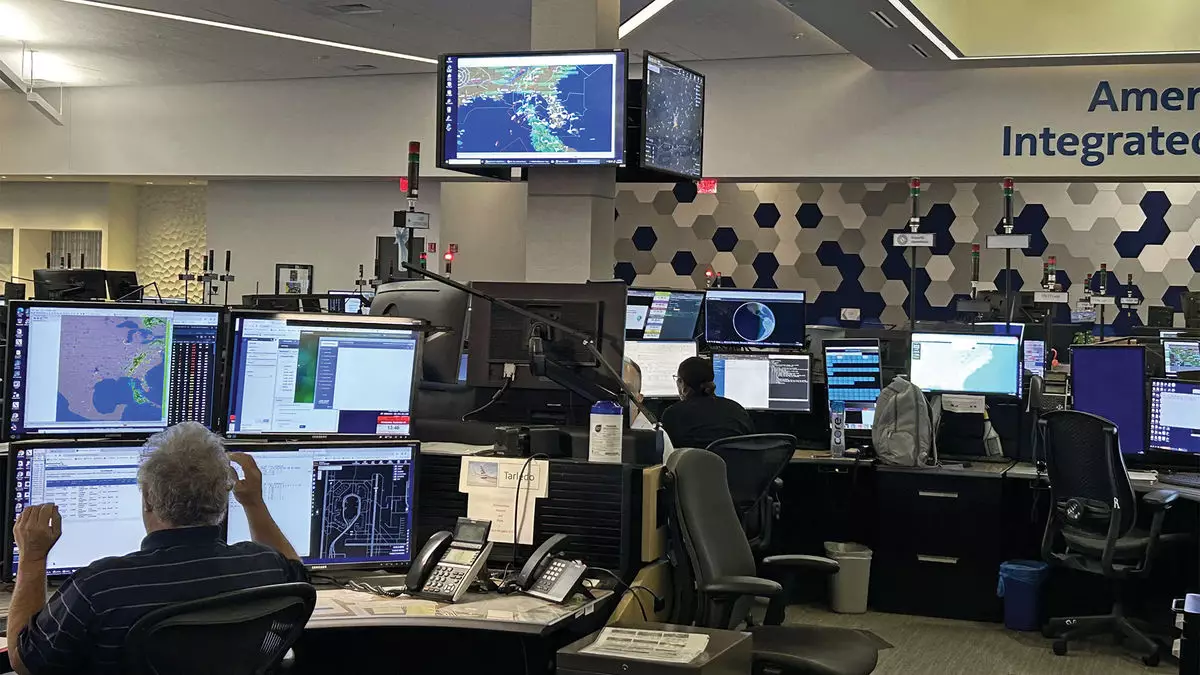Natural calamities like hurricanes present a unique set of challenges for airlines, demanding a delicate balance between operational efficiency, customer service, and safety. The incident involving Hurricane Helene in late September reveals how major airlines like American Airlines employ sophisticated strategies to navigate such turbulent circumstances.
On September 25, as Hurricane Helene swirled ominously in the Gulf of Mexico, American Airlines found itself at a pivotal juncture. While foreboding forecasts loomed large, the atmosphere within the American Airlines Integrated Operations Center (IOC) was notably calm. Mark Groat, the system customer service manager at the IOC, observed that the center was largely devoid of chaos despite the impending storm. This reflected a well-coordinated effort behind the scenes, highlighting how preparation can mitigate the typical frenzy expected during such crises.
Although the airline eventually faced the daunting task of canceling a significant number of flights due to the hurricane’s trajectory, the early day’s minimal disruptions signaled a strong advance strategy. A mere 44 flights were canceled for the subsequent day, indicating preemptive measures that were already in play, particularly in high-impact areas like Tampa, where airports announced closures ahead of the storm.
Visionary preparation marked American Airlines’ approach to Hurricane Helene. On that fateful morning, the IOC maintained active communication with airport general managers across Florida. This crucial dialogue aimed to assess operational constraints resulting from the hurricane’s anticipated impacts. Early interventions, such as issuing flight waivers in advance, equipped ticketed travelers with the flexibility needed amidst uncertainty. This preparation enabled the airline to respond fluidly as conditions evolved, recognizing that hurricane-force winds would persist long after landfall.
In addition, Cancun posed its own challenges, as the resort city began to feel the preliminary effects of the hurricane. However, thanks to the IOC’s in-house weather team and strategic adjustments, the airline managed to temporarily postpone flights rather than cancel them outright. The ability to adapt quickly not only reduced disruptions but also demonstrated a commitment to maintaining service continuity under duress.
Key to American Airlines’ operational resilience is the use of advanced technology. The airline employs a proprietary system known as the Hub Efficiency Analytics Tool (HEAT), which assesses a range of variables—from air traffic control constraints to weather conditions—to optimize flight schedules. This level of data-driven analysis allowed dispatchers to gauge the expected traffic flow, particularly at heavily impacted hubs like Charlotte.
The complexity of the operational puzzle is further intensified by air traffic control regulations. If traffic restrictions are anticipated, the ability to delay specific flights ensures that airport capacity is not overwhelmed. Between September 25 and 28, American was able to adapt its operations, resulting in 38% of arrivals in Charlotte being delayed solely as a preventative measure, thereby minimizing cancellations.
In addition to managing cancellations and delays, American Airlines took proactive steps to facilitate evacuations from high-risk areas. The company began to sell additional flights from Tampa prior to the airport’s closure. This initiative served three essential purposes: providing an essential escape route for evacuees, relocating aircraft to safer zones, and generating revenue at a critical time.
This strategic foresight underscores how airlines can leverage operational flexibility to not only protect their assets but also fulfill a vital role in community safety during extreme weather events. For instance, as Groat noted, an impromptu flight from Tampa to Dallas garnered 45 passengers within its first hour of availability.
Effective decision-making during storm conditions is not a solo endeavor; it requires collaboration among various operational divisions. The lead dispatcher plays a crucial role in final determinations regarding cancellations and delays, drawing on insights from maintenance, scheduling, and customer service teams. This integrative approach ensures that critical decisions take into account maintenance needs, crew availability, and passenger impact.
For example, if a scheduled flight includes a significant number of passengers who need to connect to an international journey, the priority may shift to preserving that particular flight’s schedule. Thus, the operational landscape for airlines becomes an intricate jigsaw puzzle, where each piece must interlock seamlessly for the greater good of both the airline and its customers.
Hurricane Helene illuminated the intricate and often chaotic world of airline operations in times of crisis. The ability of American Airlines to maintain composure, leverage technology, and collaborate across divisions exemplified a commitment to customer service amid adversity. This case serves as a reminder that while natural disasters can disrupt routines, proactive planning and swift adaptation are essential to sustaining operations and safeguarding passenger interests. The lessons learned can help shape even more resilient operational frameworks for future calamities.


Leave a Reply